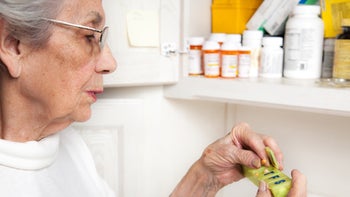
amlodipine
Amlodipine (Norvasc) is taken by mouth, typically once a day, to treat high blood pressure and coronary artery disease (CAD). It's also available as liquid options, which might be better choices for people who've trouble swallowing tablets. Most people take amlodipine (Norvasc) without experiencing many side effects. But out of the side effects people reported, the most common ones include tiredness and swelling of the hands and feet.

What is Amlodipine (Norvasc)?
What is Amlodipine (Norvasc) used for?
High blood pressure
Clogged arteries in the heart (coronary artery disease)
How Amlodipine (Norvasc) works
Amlodipine (Norvasc) is a calcium channel blocker. It works by relaxing your blood vessels to lower your blood pressure. This also helps your heart to get more oxygen so it doesn't need to work as hard to pump, which can help with chest pain.
Drug Facts
More on Amlodipine (Norvasc) essentials

Get your GoodRx coupon

What are the side effects of Amlodipine (Norvasc)?
Common Side Effects
- Swelling (2-11%)
- Tiredness (5%)
- Nausea (3%)
Other Side Effects
- Stomach pain
- Sleepiness
- Dizziness
- Flushing
- Faster heart beat
Serious Side Effects
- Dangerously low blood pressure: dizziness, lightheadedness, pale skin, feeling faint
- Heart attack: anxiety, dizziness, tiredness, cold and clammy skin, sweating, heartburn, nausea, vomiting, tightness and pain in the chest, neck, arms, or back
Source: FDA
More on Amlodipine (Norvasc) side effects
The following side effects have also been reported
Along with its needed effects, a medicine may cause some unwanted effects. Although not all of these side effects may occur, if they do occur they may need medical attention.
Check with your doctor immediately if any of the following side effects occur:
More common
Swelling of the ankles or feet
Less common
Difficult or labored breathing
dizziness
fast, irregular, pounding, or racing heartbeat or pulse
feeling of warmth
redness of the face, neck, arms, and occasionally, upper chest
tightness in the chest
Rare
Black, tarry stools
bleeding gums
blistering, peeling, or loosening of the skin
blood in the urine or stools
blurred vision
burning, crawling, itching, numbness, prickling, "pins and needles", or tingling feelings
chest pain or discomfort
chills
cold and clammy skin
cold sweats
confusion
dark yellow urine
dilated neck veins
dizziness or lightheadedness when getting up from a lying or sitting position
extra heartbeats
extreme fatigue
fainting
itching of the skin
joint or muscle pain
large, hive-like swelling on the face, eyelids, lips, tongue, throat, hands, legs, feet, or sex organs
numbness and tingling of the face, fingers, or toes
pain in the arms, legs, or lower back, especially pain in the calves or heels upon exertion
painful or difficult urination
pale, bluish-colored, or cold hands or feet
pinpoint red or purple spots on the skin
red, irritated eyes
redness of the face, neck, arms, and occasionally, upper chest
redness, soreness or itching skin
shakiness in the legs, arms, hands, or feet
slow or irregular heartbeat
sores, ulcers, or white spots on the lips or in the mouth
sores, welting, or blisters
sudden sweating
sweating
swelling of the face, fingers, feet, or lower legs
swollen glands
trembling or shaking of the hands or feet
unsteadiness or awkwardness
unusual bleeding or bruising
unusual tiredness or weakness
weak or absent pulses in the legs
weakness in the arms, hands, legs, or feet
yellow eyes or skin
Incidence not known
Abdominal or stomach pain
clay-colored stools
difficulty with speaking
headache
loss of appetite
loss of balance control
muscle trembling, jerking, or stiffness
rash
shuffling walk
twisting movements of the body
uncontrolled movements, especially of the face, neck, and back
unpleasant breath odor
vomiting of blood
yellow eyes or skin
Some side effects may occur that usually do not need medical attention. These side effects may go away during treatment as your body adjusts to the medicine. Also, your health care professional may be able to tell you about ways to prevent or reduce some of these side effects. Check with your health care professional if any of the following side effects continue or are bothersome or if you have any questions about them:
Less common
Acid or sour stomach
belching
feeling of warmth
indigestion
lack or loss of strength
muscle cramps
redness of the face, neck, arms, and occasionally, upper chest
sleepiness or unusual drowsiness
stomach discomfort, upset, or pain
Rare
Abnormal dreams
back pain
bad unusual or unpleasant (after) taste
bleeding gums
blistering, crusting, irritation, itching, or reddening of the skin
bloody nose
burning feeling in the chest or stomach
burning while urinating
burning, dry, or itching eyes
change in color of the treated skin
change in sense of smell
change in taste
changes in vision
continuing ringing or buzzing or other unexplained noise in the ears
cracked, dry, or scaly skin
decreased sexual performance or desire
difficulty with moving
difficulty with swallowing
discharge, excessive tearing
double vision
dryness of the skin
excess air or gas in the stomach or intestines
excessive muscle tone
feeling of constant movement of self or surroundings
feeling of unreality
feeling unusually cold
flushed, dry skin
fruit-like breath odor
full feeling
general feeling of discomfort or illness
hair loss or thinning of the hair
headache, severe and throbbing
hearing loss
increased appetite
increased hunger
increased sweating
increased thirst
increased urge to urinate during the night
increased urination
irritability
irritation in the mouth
lack of feeling or emotion
loose stools
loss of memory
muscle pains or stiffness
muscle tension or tightness
muscle weakness
nervousness
pains in the stomach, side, or abdomen, possibly radiating to the back
passing gas
problems with memory
redness and swelling of the gums
redness, pain, or swelling of the eye, eyelid, or inner lining of the eyelid
restlessness
seeing double
sensation of spinning
sense of detachment from self or body
shakiness and unsteady walk
shivering
sweating
swollen joints
tenderness in the stomach area
thirst
trouble in holding or releasing urine
trouble sleeping
twitching
uncaring
unexplained weight loss
unsteadiness, trembling, or other problems with muscle control or coordination
waking to urinate at night
Incidence not known
Swelling of the breasts or breast soreness in both females and males
Other side effects not listed may also occur in some patients. If you notice any other effects, check with your healthcare professional.
Call your doctor for medical advice about side effects. You may report side effects to the FDA at 1-800-FDA-1088.

Pros and cons of Amlodipine (Norvasc)

Pros
Available as a liquid (Norliqva or Katerzia) for people who have trouble swallowing tablets
Taken just once daily
Can take with or without food
Tablets are available as a lower-cost generic

Cons
Can cause swelling, so not a good choice for people with heart failure
Can cause dizziness, so raises the risk for falls
Older adults and people with liver problems are at higher risk for side effects

Pharmacist tips for Amlodipine (Norvasc)

Take amlodipine (Norvasc) with or without food at any time of day. If it hurts your stomach, try taking it with food to help.
If you're using the liquid form of amlodipine (either Norliqva solution or Katerzia suspension), use a medication dose cup or an oral syringe to measure your dose. Don't use household spoons, because they might not be accurate and might cause you to take the wrong dose. Ask your pharmacy to provide you with one if the product doesn't include it in its packaging or if you lose it.
If you accidentally miss a dose of amlodipine (Norvasc), take it as soon as you remember. But if more than 12 hours have passed since the time you were scheduled to take your dose, then skip that dose and take your next dose at your regularly scheduled time. Don't take 2 doses of amlodipine (Norvasc) at the same time to make up any missed doses.
If you don't see a change in your blood pressure right after you start amlodipine (Norvasc), it doesn't mean this medication isn't working. It typically takes about 2 to 4 weeks before you can see the full effects of amlodipine (Norvasc) on your blood pressure. During this time, your provider might adjust your dose every 1 to 2 weeks before they're able to find a dose that works best for you.
You're recommended to measure and record your blood pressure at home and bring a record of your information to your medical appointments. This information will help your provider understand how well amlodipine (Norvasc) is working for you and if they need to make any changes to your treatment.
If you're using amlodipine (Norvasc) for high blood pressure, make sure to have a healthy diet, including a low-salt diet, while taking amlodipine (Norvasc) so that the medication works even better to lower your blood pressure.
You might notice more side effects, such as dizziness or tiredness, when you first start taking amlodipine (Norvasc) or when your provider raises your dose. But these side effects should get better over time as you continue taking the medication. If they don't ease over time, talk with your provider.
Swelling in your feet, ankles, legs, hands, or arms is a common side effect of amlodipine (Norvasc). Talk to your provider if the swelling becomes too bothersome. They might recommend tips to ease the swelling, such as asking you to sit or lie down with your legs raised or to wear compression socks.
More on Amlodipine (Norvasc) tips

Frequently asked questions about Amlodipine (Norvasc)

How to save using GoodRx




What are the risks and warnings for Amlodipine (Norvasc)?
Amlodipine (Norvasc) can cause some serious health issues. This risk may be even higher for certain groups. If this worries you, talk to your doctor or pharmacist about other options.

Severely low blood pressure
Risk factors: History of narrow heart valves (aortic stenosis)
Amlodipine (Norvasc) can cause your blood pressure to drop too much, which can make you feel dizzy, tired, or lightheaded. This is a common side effect of blood pressure medications, especially when starting the medication and when the dose is raised. Your risk is higher if you have a history of aortic stenosis (narrower heart valves). If your blood pressure drops too much and you feel too dizzy, make sure to sit down slowly while holding onto something. Let your provider know because they might need to adjust the dose of your medication. If you fall and hit your head, get medical help right away.

Heart attack and chest pain
Risk factors: Severe coronary artery disease
It's possible for some people to experience worsening chest pain or develop a heart attack while taking amlodipine (Norvasc). The risk is higher when you first start this medication when your dose is raised. Your risk is higher if you have a heart problem called coronary artery disease (CAD). Get medical help right away if you experience dizziness, anxiety, chest pain, pressure in the chest, heartburn, trouble breathing, nausea, or vomiting.

Amlodipine (Norvasc) dosage forms
Typical dosing for Amlodipine (Norvasc)
Adults: The typical dose ranges from 5 mg to 10 mg by mouth once daily. The maximum dose is 10 mg daily.
Children 6 years of age or older: The typical dose ranges from 2.5 mg to 5 mg by mouth once daily. The maximum dose is 5 mg daily.
More on Amlodipine (Norvasc) dosage forms

Interactions between Amlodipine (Norvasc) and other drugs
More on Amlodipine (Norvasc) interactions
Using this medicine with any of the following medicines is usually not recommended, but may be required in some cases. If both medicines are prescribed together, your doctor may change the dose or how often you use one or both of the medicines.
- Abametapir
- Atazanavir
- Ceritinib
- Clarithromycin
- Clopidogrel
- Conivaptan
- Cyclosporine
- Dantrolene
- Digoxin
- Domperidone
- Droperidol
- Epirubicin
- Fosnetupitant
- Lacosamide
- Netupitant
- Piperaquine
- Rifampin
- Ritonavir
- Simvastatin
- Tacrolimus
- Tegafur
- Telaprevir
Using this medicine with any of the following medicines may cause an increased risk of certain side effects, but using both drugs may be the best treatment for you. If both medicines are prescribed together, your doctor may change the dose or how often you use one or both of the medicines.
- Indinavir
- Rifapentine

How much does Amlodipine (Norvasc) cost?

What are alternatives to Amlodipine (Norvasc)?
High blood pressure
Clogged arteries in the heart (coronary artery disease)
High blood pressure (hypertension)
Chest pain (angina)
High blood pressure (hypertension) - extended-release tablets only

What is the latest news about Amlodipine (Norvasc)?

Amlodipine (Norvasc) images
Get savings updates for Amlodipine (Norvasc)
Receive price alerts, news, and other messages from GoodRx about Amlodipine (Norvasc) and other healthcare topics and relevant savings offers.By signing up, I agree to GoodRx's Terms and Privacy Policy, and to receive marketing messages from GoodRx.
Compare other Hypertension, Coronary Artery Disease, Angina drugs
Browse medications
View AllResearch prescriptions and over-the-counter medications from A to Z, compare drug prices, and start saving.


















